#immune system
Meet your immune army
Your immune system works day and night to defend your body. An army of specialist cells are on hand to target and destroy pesky invaders - whilst leaving your own cells unharmed.
In the video above you can see Memory T cells (green) moving across skin. Memory T cells patrol barriers in case of re-infection by a similar pathogen.
Researchers at the Babraham Institute are trying to understand how the different immune cells develop and work.
Video credit: Babraham Institute

1. Enhances Brain Function
Maybe the most thoroughly researched feature of lion’s mane mushroom is its impact on brain cells and related functions. This incredible fungus may have revolutionary impact on neurodegenerative diseases.
One method by which lion’s mane affects brain function is by enhancing “neurite outgrowth” in the brain and related organs, according to research published in the International Journal of Medicinal Mushrooms. (3,4) Neurite outgrowth refers to the growth of axons and dendrites from neurons (anybody’s high school biology classes coming back?).
That’s a big deal in brain health research. By increasing this growth, it could potentially be possible to slow or reverse cell degeneration in the brain — the main characteristic of diseases like Alzheimer’s and Parkinson’s.
A 2012 study conducted in Malaysia found that consuming lion’s mane mushroom could actually regenerate damaged cells from peripheral nerve injury, an injury affecting the delicate tissue between your brain and spinal cord. (5)
When studying how brain diseases might be affected by particular medications or treatments, scientists often use what is known as the PC12 cell line for testing. Extracts and various forms of lion’s mane mushroom seem to have a major impact on PC12 cells, protecting them from damage and delaying their cell death significantly. This finding may prove to be extremely relevant for prevention or treatment of brain conditions. (6,7,8)
In animal research published in Evidence-Based Complementary and Alternative Medicine, lion’s mane mushroom stimulates cognitive function and helps improve memory in rats, both with and without an Alzheimer’s model. (9) Multiple studies have found an inverse correlation between lion’s mane and Alzheimer’s-related symptoms, meaning that after consuming the mushroom extract, the rats’ symptoms improved. (10,11)
An improvement of mild cognitive impairment in humans was also found in research published in Phytotherapy Research after eight to 16 weeks of lion’s mane supplementation, although this improvement did not last after subjects stopped taking this supplement. (12)
The danger of ischemic injury (damage caused by a lack of blood flow) to neurons is also of significance when you’re talking about brain damage and disease. In laboratory tests conducted in Taiwan, lion’s mane mushroom has been shown to help prevent this type of injury. (13)
Taking supplements of lion’s mane has also been found to have potentially protective effects on the spread of Parkinson’s disease, another neurodegenerative disorder, according to research published in the Journal of Translational Medicine. (14)
While this research is still in its infancy and has not progressed to large-scale human trials in most cases, the consistent effect lion’s mane mushroom has been found to have on brain cells should not be ignored.
2. May Protect Against Cancer
Lion’s mane may also be significant in treating cancer, according to a host of research. (15) In varying degrees, compounds from or supplementation with lion’s mane mushroom has been found to potentially slow the progression or reverse the spread of: leukemia cells in a Korean study. (16) Further Korean research conducted by the Department of Molecular Science and Technology at Ajou University found that thanks to the phytochemicals in lion’s mane mushroom, it has “therapeutic potential against human leukemia.” (17)
As far as gastric cancer is concerned, a study published in the International Journal of Biological Macromolecules found that lion’s mane caused cell death and cell cycle arrest with gastric cancer. The researchers concluded, “our study provides in vitro evidence that HEG-5 may be taken as a potential candidate for treating gastric cancer.” (18)
Studies published in the Journal of Natural Products and Kaohsiung Journal of Medical Sciences unearth the ability of lion’s mane mushroom to treat lung cancer. (19,20) Meanwhile, according the Journal of Biomedicine and Biotechnology and the Journal of Ethnopharmacology, lion’s mane exhibits anticancer activity against colon, breast and other cancers as well. (21,22)
Some studies actually suggest the use of lion’s mane mushroom supplements to treat cancer, although long-term and large-scale studies haven’t been conducted to prove that as a viable option.
Another interesting finding involved the metastasis (cancer spreading) from the colon to the lung. When a cancer spreads to more than the original organ in which it was found, a patient is considered to have stage IV cancer. In a study conducted on rats out of Korea, rats were given either hot water lion’s mane extract or microwaved ethanol extracts of lion’s mane mushroom. By consuming lion’s mane extract, the rats studied showed inhibited metastasis of cancer cells to the lungs by 66 percent and 69 percent, respectively. (23)
3. Supports Heart and Circulatory System Health
Lion’s mane mushroom might also help you in preventing heart disease. Research has found that extracts of lion’s mane can prevent the increase of LDL cholesterol (sometimes referred to as “bad” cholesterol), increase HDL, or “good,” cholesterol and lower triglycerides in the bloodstream, an early indicator of heart disease. (24,25)
Stroke, a lack of blood supply to the brain from the heart, is sometimes caused by blood clots. It’s also related to atherosclerosis, a serious heart condition. An extract of lion’s mane mushroom may be able to prevent blood clots and help to reduce the risk of stroke, according to a study by from the Department of Cellular Signaling, Graduate School of Pharmaceutical Sciences at Tohoku University in Japan. (26)
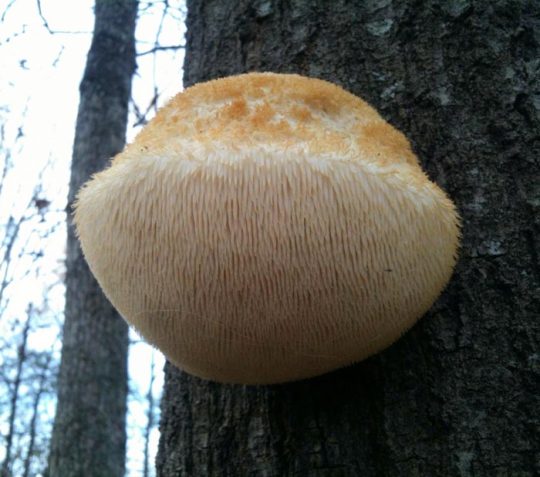
4. Might Improve Digestive Health
Due in part to its powerful anti-inflammatory properties, lion’s mane mushroom might improve the function of your stomach and digestive system.
In multiple studies, lion’s mane mushroom has been shown to protect from or shrink gastric ulcers. For instance, according a study conducted on rats by the Mushroom Research Centre at the University of Malaya in Malaysia, researchers concluded the bioactive compounds in lion’s mane extract may be responsible for the gastroprotective activity exhibited on the rats. (27) Research from China published in the International Journal of Medicinal Mushrooms confirms this, noting that “results indicate that the polysaccharide fraction is the active component of the H. erinaceus mycelium culture, which protects against gastric ulcers.” (28)
Lion’s mane may also significantly improve symptoms of two major inflammatory disorders of the digestive system, gastritisandinflammatory bowel disease. (29,30)
5. Reduces Inflammation
Although it’s a relatively different way of looking at health, research on natural ways to reduce inflammation is a major way natural health practitioners help prevent disease.
A 2015 study out of Japan found that lion’s mane mushroom was able to reduce inflammation in fatty tissue. This is important because fatty tissue inflammation is a factor in the formation of metabolic syndrome, a cluster of conditions that increase your risk of heart disease, stroke and diabetes. (31)
Lion’s mane also has antibacterial effects against h. Pylori, often considered “the most successful pathogen in human history.” Many people never have symptoms of carrying the bacteria, but for some people it causes severe gastric conditions, like ulcers in the stomach and/or intestines.
6. Acts as a Powerful Antioxidant
Fighting free radical damage has a number of health benefits, including the prevention of disease. The molecules in lion’s mane mushroom have antioxidant abilities and help prevent and relieve the oxidative stress caused by poor nutrition and exposure to chemicals in the environment. (34,35)
One specific way these antioxidants may be useful is in the healing of wounds. A study at the University of Malaya found that a liquid extract of lion’s mane sped up wound healing significantly compared to natural healing in rats. (36)
7. Improve Mental Health and Overall Well-Being
A lion’s mane mushroom supplement may also help you to feel better by improving sleep and reducing the effects of mental health issues.
The powerful polysaccharides extracted from lion’s mane have been shown to fight fatigue in mice trials. (40) They also might have the ability to adjust circadian rhythms back to normal, as they did on mice in a study conducted at the Department of Agro-environmental Sciences, Faculty of Agriculture at Kyushu University, which is particularly significant for people who are at risk for dementia. (41)
Consuming lion’s mane mushroom may also be a natural remedy for depressionandanxiety. Thirty women were given either a placebo or lion’s mane for four weeks. Researchers concluded, “Our results show that HE intake has the possibility to reduce depression and anxiety and these results suggest a different mechanism from NGF-enhancing action of H. erinaceus.” (42) This seems to be related, in part, to the inflammation factor related to depression, as shown in mice studies. (43)

8. Improves Immune Function
It’s important to know how to boost your immune system so your body can fight infection well. Lion’s mane seems to have the ability to enhance immune system function in a manner also related to the polysaccharide content in the fungus, according to research performed on mice. (44)
9. Might Be Useful for Managing Diabetes
A 2013 animal study showed marked improvement in blood glucose levels, insulin sensitivity and various other diabetes symptoms when an extract of lion’s mane mushroom was given to them. (45)
Possibly because of the antioxidant activity of lion’s mane, administering it to animals also seems to relieve pain caused by diabetic neuropathy.
>>>Always buy only products that contain more than 30% polysaccharides, preferably up to 50%.<<<
Oh, and btw there´s a guy who plays synths with mushrooms:
Why people on immunosuppressant drugs for autoimmune conditions have a higher incidence of an often-fatal brain disease may be linked to a mutation in a common virus, according to researchers at Penn State College of Medicine.
Progressive multifocal leukoencephalopathy (PML) is a rare disease of the brain’s white matter caused by the John Cunningham polyomavirus (JCV), a usually harmless virus that infects up to 80 percent of healthy adults.
In the past, the virus usually only developed into brain disease in individuals with suppressed immune systems, such as AIDS patients and organ transplant recipients on immunosuppressant medications. Over the past decade, however, new drugs for a variety of autoimmune conditions have been identified as a key risk factor for the brain disease.
The disease is now most common in multiple sclerosis patients who have the virus and who receive an immunosuppressant therapy called natalizumab. Patients with Crohn’s disease, psoriasis, rheumatoid arthritis, B cell lymphoma and chronic lymphocytic leukemia have also developed the devastating brain disease after immunosuppressant therapy with natalizumab and other drugs.
“Nobody comes away unscathed from PML—you either die or you’re left with a lifelong searing neurological defect,” said Aron E. Lukacher, chair and professor of microbiology and immunology. “Because we don’t know how the drugs cause the JC virus to amplify from a silent infection, we really have no way of controlling it.”
When other researchers studied the virus in patients with PML, they found a mutation in its protein shell, the part that allows it to bind to and infect human cells.
In the new study, Lukacher’s team sought to answer the question: Could this mutation affect how the immune system responds to the infection?
To answer this, the researchers developed a new mouse model of polyomavirus infection that shares many characteristics that are seen in progressive multifocal leukoencephalopathy.
They learned that mice with mutated polyomavirus strains had a reduced T cell response, the major part of the immune system that protects against the virus.
“We found that mouse polyomaviruses with a single amino acid change in their shell elicit a very different magnitude and quality of the T cell response that is needed to control the infection,” Lukacher said.
The researchers also found that a signaling protein called type I interferon controlled the difference in T cell response in mice with this mutant polyomavirus.
Type I interferon directly controlled the ability of the virus to grow in mouse cells, the researchers said. It also controlled the size of the T cell expansion and the function of these immune cells against the infection.
These findings raise the possibility that viral shell mutations may influence the T cell response to John Cunningham polyomavirus in humans, and play a role in the development of progressive multifocal leukoencephalopathy, the researchers wrote in the Journal of Virology.
It is still unknown how immunosuppressant therapies may cause these mutations in JCV, the researchers said. However, understanding the importance of the T cell response could help researchers prevent the development of progressive multifocal leukoencephalopathy in autoimmune patients.
“We need to find ways to improve the T cell responses in patients on these therapies,” Lukacher said.

Everybody is talking about it. It’s shaping up to be one of the worst flu seasons in years. And, with all the commotion It never fails, we hear it every year-“Nah man, I don’t mess with the flu shot! The last time I got it, it gave me the flu!” Or, the always classic “Why would I get that shot again? Last year I got it, and still got the flu!”. With that being said, we decided to sit down and put together a short article on why getting the flu shot won’t give you the flu, but also why it can’t guarantee you won’t get it either.
THE BASICS:Without getting too “sciency” on you, lets talk about the flu shot itself. When you get a flu shot, what you’re actually getting is what’s known as a “dead virus”, which means the virus in the shot is, well, dead. “There is simply no way that the flu vaccine can give you the flu,”saysChristine Hay, MD, assistant professor at the University of Rochester Medical Center. “It’s impossible” (we’ll explain why it’s impossible later).
“WHERE MY DOGS AT?”: At this point, you’re probably wondering to yourself, if what’s in the flu-shot is “dead” then what’s the point of getting it, right? Fair question, and here’s a simple way to think of it. Your body has its own defense against “intruders” (i.e. your immune system), you can think of these as guard dogs, running throughout your body, attacking suspicious looking characters who might otherwise do you harm. These guard dogs have been trained to sniff out your run-of-the-mill “home intruders”, so most of the time when an intruder (playing the role of a virus in our scenario) tries to make its way into your body, your dogsare on the prowl and ready to handle your dirty work!
There’s only one problem in this hypothetical scenario. Every year the home intruders get a little more clever, and they switch things up. Maybe they ditch the ski mask, its too obvious. Instead, this year they decided to roll with the hoodie instead, it’s a little less suspicious. Now imagine the intruder makes his way inside your house, and it isn’t until he starts wrecking shop that your guard dogs realize “Aww snap! We have a problem here!” at which point they jump into action and try their best to control the situation. But, they’re a little late to react to the intruder (they didn’t know what to make of their new disguise at first), and he was able to break a few things and got away with some property.
Granted, the dogs eventually sprung into action, but the damage had already been done. They only upside to this scenario is that if the home intruders come around again, dressed similarly to the recent intruders (i.e. wearing hoodies), your dogs will be ready to spring into action.
FLU-SHOT IN TRAINING: What the flu shot does is basically offer up “training” for your guard dogs. The three most common “looks” for home intruders in your neighborhood are identified, rag-doll versions of them are made, and dressed to look exactly like them. The dogs are then introduced to the rag-doll intruders, and trained to attack them on sight! Even if it takes them a little while to be trained (just like it takes the flu shot a few weeks to “kick in”), it’s okay because the rag-dolls pose no threat, they’re not real, just as the dead virus in the flu-shot is not a threat.
The idea is this: Now that the guard dogs know what they’re looking for, if and when the actual intruders show up, there will be little to no delay in attacking, and shutting them down! With no time to wreck shop, the bad guys stand little chance to do any harm to the home or the people inside!

SO, WHY DID I STILL GET THE FLU LAST YEAR?: Now that you (hopefully) have a little better understanding of why we get flu shots, and how they work, lets talk about why some people still get the flu, despite having received their shot. One explanation is simply that (again, continuing with our guard dog and home intruder analogy from above) the home intruder was not dressed like one of the three included in the vaccine. Makers of the the flu-shots do their best to identify the top three strains they think will most likely be infecting people in your area. However, there is no way they can possibly account for allof the flu strains (just like it would be impossible to guess what everypotentialhome intruder would look like). But, life is all about percentages and odds, so the idea is to stack the odds in your favor: If you’re at risk for catching the flu (which we all are), here are the most likely critters to get you, and here is a vaccine against those strains. It’s that simple.
A more obvious explanation can be that you were exposed to the flu virus before you received your shot, or in the two weeks it takes for the shot to start protecting your body. Lastly, some people just love a good conspiracy theory, and at the first sign of a sniffle or a cough, will mistake their symptoms for the flu instead of what it actually is, a simple cold.
Injury-Duty Insight:There you have it. Now you know how the flu shot works, and even why it sometimes doesn’t. Keep in mind that flu seasonin the United States tends to start around November and continues to peak all the way through April, so there’s plenty of reason to still go out and get yours, should you want it. Also keep in mind that children (over 6 months) and elderly (over 65 years old) should be first in line to get their shots, because the babies, well their guard dogs are just puppies (they need all the training they can get!) and the older folks, well their guard dogs don’t react as quickly as they used to, so they need all the head-start they can get!
(Like What Found Here? Have Comments, Questions? Concerns? Visit Out Injury-Duty Facebook Page of Follow Us On Twitter @Health_ID)
Sources:
1. Christine Hay, MD, assistant professor, University of Rochester Medical Center, Rochester, N.Y.
23 Hot Health Tips
1. Drink 6 – 10 cups of warming liquids such as hot water and herbal teas to prevent dehydration.
2. Eat freshly prepared warm food to enhance circulation and increase warmth in your body.
3. Keep warm by wearing warm, natural fiber clothes.
4. Increase your fiber intake to keep bowels clean.
5. Add these strengthening warming vegetables to your meals: avocados, beets, brussels sprouts, carrots, pumpkins, winter squash, sweet potatoes, cabbage, onions and mung beans.
6. Get enough sleep. We need 7-8 hours of sleep per night. When we are not getting enough sleep, our bodies become vulnerable to illness. Sleep is fuel!
7. Eat bitter greens like radicchio, arugula, endive, and cabbage for balancing in this season.
8. Avoid tomatoes, cucumbers and leafy lettuce (these are cooling summer foods).
9. Give yourself a daily sesame oil massage to moisten the skin in this dry season and to calm the nervous system. It is rich in fatty acids to help repair dry skin making it soft and smooth.
10. Every day go for a 20 to 60 minute walk out in the fresh air. Even when it’s cold, this helps connect you with the earth and air.
11. Drink warming herbal teas with spices like ginger, cinnamon and cardamom tea.
12. Avoid refined sugar which weakens the immune system.
13. Use healthy sweeteners (in limited quantities) like Manuka Honey which will strengthen the immune system, Molasses full of iron and other minerals and coconut sugar with its low glycemic index.
14. Read books, listen to music, meditate or whatever is restful for you. Good rest is vital to balance.
15. Eat nuts and seeds (in limited quantities) like Almonds, Cashews, Brazil nuts, Walnuts, Hazelnuts, Flax seeds and Sesame seeds. These will provide necessary vitamins and natural oils and provide required nutrients to keep the body warm.
16. Use spices like Fennel, Cumin, Coriander, Ginger, Anise, Cinnamon, Black pepper, Turmeric, Mustard seeds and Cardamom to help the digestion and help eliminate gas.
17. Avoid cold foods and iced drinks; that means no ice cream too.
18. Get some direct sunlight as much as possible. There is less sun in winter but your body craves it.
19. Cut out mucous forming foods like dairy, eggs and wheat especially if you are prone to colds and flues.
20. Eat gluten free grains like quinoa, buckwheat, brown rice and millet; they are full of nutrients and not clogging to a sensitive winter digestive system.
21. Eliminate refined oils and include healthy fats that are cold pressed (Almond oil, Coconut oil, Olive oil, Sesame oil, and Ghee).
22. Eat fruits rich in vitamin C like oranges, lemons and tangerines which will help flush out toxins from the body.
23. Have a warm bath or foot bath with Epsom salts daily (not too hot or too long as this can deplete energy).
How Gardening Benefits your Mind and Body [Visual]
→http://ecogreenlove.com/?p=15744While it may not be the first activity you consider exercise, according to the Centers for Disease Control and Prevention (CDC) gardening does in fact qualify as exercise. Not only does gardening impact our physical health, but it supports our mental health as well. Here are just a few of the many benefits gardening has on our health.
-
#gardening #wellbeing #healthtips #fitness #healthbenefits #communitygarden
#mentalhealth #immunesystem #brainhealth #healthierlife
Post link
How Gardening Benefits your Mind and Body [Visual]
How Gardening Benefits your Mind and Body [Visual]
#gardening #wellbeing #healthtips #fitness #healthbenefits #communitygarden
While it may not be the first activity you consider exercise, according to the Centers for Disease Control and Prevention (CDC) gardening does in fact qualify as exercise. Not only does gardening impact our physical health, but it supports our mental health as well. Here are just a few of the many benefits gardening has on our health.
(more…)

Measles Virus May Wipe Out Immune Protection For Other Diseases
by Emily Vaughn / NPR Health
This year saw the largest outbreak of measles in the U.S. since 1994, with 1,250 cases reported as of Oct. 3, largely driven by families choosing not to vaccinate their kids. Worldwide, the disease has resurfaced in areas that had been declared measles-free.
Some families choosing not to vaccinate argue that measles is just a pesky childhood illness to be endured. But two new studies illustrate how skipping the measles vaccine carries a double risk. Not only does it leave a child vulnerable to a highly contagious disease, but also, for individuals who survive an initial measles attack, the virus increases their vulnerability to all kinds of other infections for months, possibly even years, after they recover.
The research begins to explain something surprising that happened when the measles vaccine was introduced in the U.S. in the 1960s. Rates of childhood deaths from other diseases fell precipitously. The same thing happened as the vaccine was introduced around the world.
But what is it about the measles vaccine that seems to provide protection from more than just measles? The new studies published this week in the journals Science and Science Immunology provide substance to what has been the leading theory: Measles can damage the immune system by erasing the body’s memory of previously encountered antigens.
Image above © James Cavallini / Science Source
Post link
-Alemtuzumab year 2
This year has definitely been easier than last year was! My younger sister came to stay for a week and helped me with everything which did make life that little bit easier. She did the same last year too; what a star! Thanks Flea!! Don’t get me wrong, I’m super tired and could really do with doing very little for a while (or my sister back? haha) but I’ve been back at work for a week now and it didn’t kill me!
I have had a lot of tingling in my limbs (a.k.a. altered sensation), not something I’m that used to, and headaches on and off…but apart from that & a couple of little blips, it’s been ok.
All I have to do now is avoid catching anything and I’ll be happy!
– Days 1, 2 & 3
Here’s a quick update to changes to the treatment plan for this year:
1) The ‘anti-listeria’ diet we are asked to follow has been extended to a month before the treatment starts. We had of course been told this prior to this meeting, but she explained that it was because there had been a death caused by listeria in a patient receiving Alemtuzumab. (Thank goodness I’d followed the instructions, hey!)
2) We would be taking a second tablet (in addition to the acyclovir) home with us this year; it’s an antibiotic called Co-Trimoxazole (2x480mg a day for 30 days, each containing: 80mg Trimethoprim & 400mg Sulfamethoxazole), which has been shown to decrease the risk of getting ill whilst our immune systems are very low.
So, for the second round of Alemtuzumab I had 3 days of treatment. I’m not entirely certain why it’s shorter than the first year, but I do know that this is the standard protocol. This year wasn’t very different from last year except, I suppose, that it was a little easier. I’m not sure if that was because I knew what to expect, or that fewer days meant that my body felt less bombarded (or maybe a bit of both?), but either way, I was glad for it!

(This is Morriston the sloth (named after the hospital that my neuro team are based in) sitting in the chair that was my home for the three days of my treatment this year.)
Day one
We started today with some introductions: Mark & I had a new buddy this year called Jenny (also in her 2nd year) and we all met the new neurologist that has been added to our neuro team; both were great. We then each had a little consultation with said neuro who just went through a few things and did a quick series of tests. All we had to do then was wait for the results of our urine tests, take an antiviral & antihistamine, to be cannulated and we were good to go.
There was around an hour of steroids and then 4ish hours of the Alemtuzumab, followed by 2 hours of observation and a blood test. We had half-hourly obs all day and we mainly looked after by 2 nurses. The unit we were in was being shared with the renal department so there was a steady stream of their patients coming in and out for various treatments all day.
I spent this day in quite a lot of discomfort but I knew it was to be expected. The nurses gave me some paracetamol and said that it was good because it meant it was working. At the time all I wanted to do was cry, but looking back on it that was the worst part of the treatment this year and it really wasn’t that bad.
Mum & I stayed in a hotel again as it was much easier and safer to be near the hospital. I was pretty tired after the first day but when trying to sleep I became VERY restless.
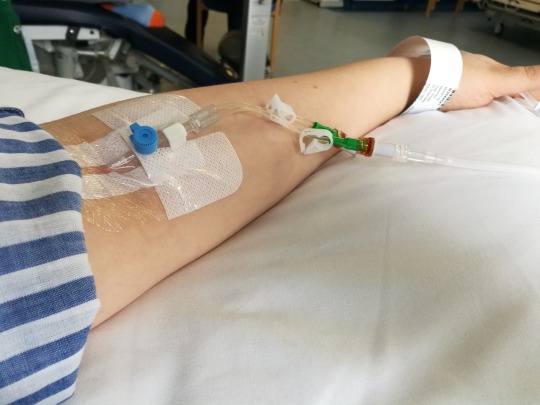
(Cannula number 1)
Day two
I had kept the cannula in from the day before so today started a lot faster than the first. All I had to do was wait for my urine test to show all clear and for the blood results from day one to confirm that the treatment had done what it was meant to do. Both were fine, so, after taking an antiviral and antihistamine again, off we went. I had a headache this day and was quite sleepy, but that was pretty much it.
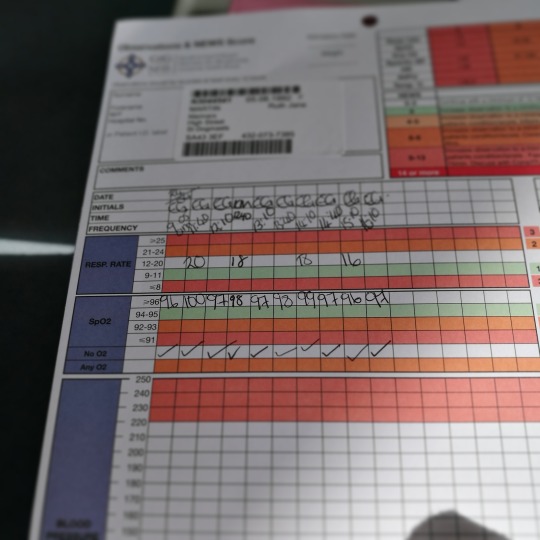
(Half of the obs sheet from day 2)
Day three
I’d kept the cannula in again for this day but about 30 minutes into the steroids it had to be taken out and replaced on the other side. It was a little painful and the infusion seemed to be going quite slowly so it was decided that it was best to change it. Turned out that was a good idea as when it came out the tube was so bent they didn’t even know how it had been going through in the first place (haha). Apart from that the same morning routine from the day before was followed. I was a little flushed this day and had a bit of a temperature but they both went down by the end of the day. I was a lot more tired so spent a lot of the day in and out of sleeping. I did get a small rash, but NOTHING compared to the one I got last year!
So, that was Round 2…hopefully my last! I have a check-up appointment with one of my neurologists in a month and will have an MRI in June(ish) and then we’ll go from there. Keep your fingers crossed for me!
I just wanted to add a quick thank you to my Mum, sisters and friends that looked after me and messaged me throughout these 3 days! Oh, and the awesome neuro team at Morriston (thank goodness for the NHS!!)!
I haven’t had to update this in a while, which has been good, in this case no news really has been good(ish) news.
So what’s happened since last April? To sum up:
> I caught so many bugs it was unbelievable, but none of them caused any hospital visits and as my immune system regained its strength I did stop catching everything.
> I have Trigeminal Neuralgia & take Carbamazapine to stop it from causing me pain, which coincidentally has also seemed to help my back problems.
> I still have to use crutches every so often, but much less than I was starting to use them.
> I’ve had 3 mysterious skin allergic reactions (as shown in previous post), around 10 issues with my eye - itching/pain - that was stopped by piriton - & now have very dry skin/eczema on my eyelids (Aveeno cream clears it up within 24 each time). The GP I saw has suggested that this is all an allergic reaction to the TN meds, but the TN is definitely still worse than all of that. I’m yet to see if my neuro agrees…
> I had a 2 week spell of headaches behind the eyes couple with some mild vertigo recently, but optician couldn’t find an issue, neither could the GP. Again, yet to really bring it up with anyone on the MS team.
> Fatigue, stiffness and memory issues are unfortunately still ever present, but I think they might be something that stick with me for ever to be honest.
> There have (of course) been other issues here & there, but right now none spring to mind…
npr:
Ebola has a nasty reputation for damaging the body, especially its blood vessels. But when you look at the nitty-gritty details of what happens after a person is infected, a surprising fact surfaces.
How Ebola Kills You: It’s Not The Virus
Illustration credit: Lisa Brown for NPR
Post link
Thethymus is a specialised primary lymphoid organ of the immune system.
- At its largest and most active during the neonatal and pre-adolescent periods.
- Decreases in size and activity through teenage years
- Thymus tissue is gradually replaced by adipose tissue(fat).
- Residual T lymphopoiesis continues throughout adult life.
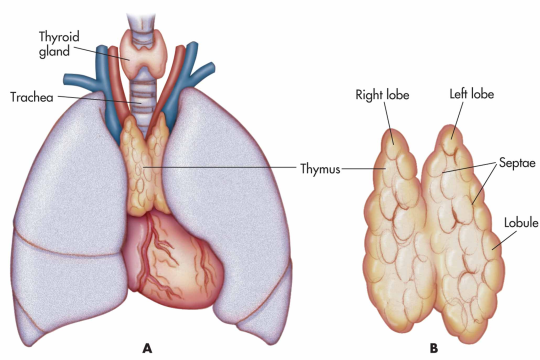
The thymus is composed of two identical lobes and is located in the anterior superior mediastinum, in front of the heart and behind the sternum. Each lobe of the thymus can be divided into a central medulla and a peripheral cortex which is surrounded by an outer capsule.
Function
Facilitates the maturation of T cells - which provide cell-mediated immunity.
- T cells begin as hematopoietic precursors from the bone-marrow, and migrate to the thymus, where they are referred to as thymocytes.
- In the thymus they undergo a process to ensure the cells react against antigens (“positive selection”), but that they do not react against antigens found on body tissue(“negative selection”).
- Once mature, T cells emigrate from the thymus to provide vital functions in the immune system.
- Each T cell has a distinct T cell receptor, suited to a specific substance, called an antigen.
- Most T cell receptors bind to the major histocompatibility complex on cells of the body.
Positive selection
T cells have distinct T cell receptors. These are formed by process recombination gene rearrangement which is error-prone, and some thymocytes fail to make functional T-cell receptors, whereas other thymocytes make T-cell receptors that are autoreactive. The survival and nature of the T cell then depends on its interaction with surrounding thymic epithelial cells.
- T cell receptor interacts with the MHC molecules on the surface of epithelial cells.
- A T cell with a receptor that doesn’t react, or reacts weakly will die by apoptosis.
- A T cell that does react will survive and proliferate.
- A mature T cell expresses only CD4 or CD8, but not both.
Negative selection
T cells that attack the body’s own proteins are eliminated in the thymus. Epithelial cells in the medulla and dendritic cells in the thymus express major proteins from elsewhere in the body. Some CD4 positive T cells exposed to self antigens persist as T regulatory cells.
Pathology
Immunodeficiency - As the thymus is the organ of T-cell development, any congenital defect in thymic genesis or a defect in thymocyte development can lead to a profound T cell deficiency in primary immunodeficiency disease.
Autoimmune disease - Genetic disorders, such as Myasthenia gravis: caused by antibodies that block acetylcholine receptors.
Thymomas - Originate in thymic epithelial cells most often in adults older than 40. Generally detected when they cause symptoms, such as a neck mass or affecting nearby structures such as the superior vena cava. Can be benign; benign but by virtue of expansion, invading beyond the capsule of the thymus (“invasive thyoma”), or malignant (a carcinoma).
Lymphomas - Tumours originating from T cells of the thymus form a subset of acute lymphoblastic leukaemia (ALL)
Thymic cysts - The thymus may contain cysts, usually less than 4 cm in diameter. Thymic cysts are usually detected incidentally and do not generally cause symptoms.
Oddly not mentioned: vaccines, the very definition of immune system activation and Hep B routinely given at birth?
Immune System Activation in Newborns May Affect Developing Brain
McLean Hospital neuroscientists have found that even a brief episode of immune system activation within days of birth can cause persistent changes in sleep patterns concurrent with increases in epilepsy-like brain activity—a combination of symptoms common in autism spectrum disorder (ASD) and other developmental conditions. The detailed findings are available in the January 12, 2018 issue of Neuropsychopharmacology.
“A growing body of evidence suggests that immune system activation, such as that caused by bacterial and viral infections, can play important roles in many brain disorders,” explained Bill Carlezon, PhD, chief of the Division of Basic Neuroscience at McLean Hospital, and senior author of the paper. “While previous research in laboratory animals has established that immune activation during critical prenatal (before birth) developmental periods can later produce the core features of ASD, including decreased social interaction, aberrant communication, and increased repetitive behavior, we wanted to evaluate whether postnatal (during infancy) immune activation could also produce other symptom clusters that are often seen in ASD and related conditions.”
Full open access research for “Perinatal Immune Activation Produces Persistent Sleep Alterations and Epileptiform Activity in Male Mice” by Galen Missig, Emery L Mokler, James O Robbins, Abigail J Alexander, Christopher J McDougle & William A Carlezon Jr in Neuropsychopharmacology. Published online October 6 2017 doi:not available
Post link
When your immune system is so shot that you only just got over being sick….and you’re sick again.
Plantibodies and Plant-Derived Edible Vaccines
Throughout history, humans have used plants in the treatment of disease. This includes more traditional methods involving direct consumption with minimal preparation involved and the extraction of compounds for use in modern pharmaceuticals. One of the more recent methods of using plants in medicine involves the synthesis and application of plantibodies and plant produced antigens. These are recombinant antibodies and antigens respectively, which have been produced by a genetically modified plant (1, 2).
Antibodies are a diverse set of proteins which serve the purpose of aiding the body in eliminating foreign pathogens. They are secreted by effector B lymphocytes which are a type of white blood cell that circulate throughout the body. An antigen is a molecule or a component of a molecule, such as a protein or carbohydrate, which can stimulate an immune response. The human body is capable of producing around 1012 different types of antibodies, each of which can bind to a specific antigen or a small group of related motifs (3). When an antibody encounters the antigen of a foreign pathogen to which it has high affinity, it binds to it which can disable it or alert the immune system for its destruction (4).
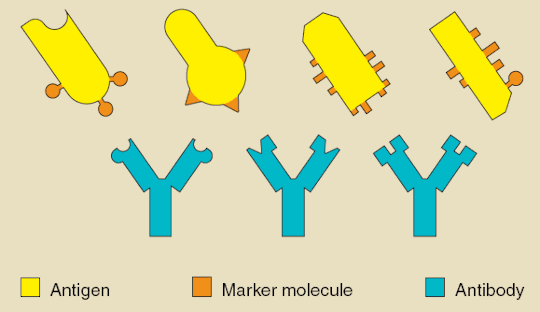
Plants do not normally produce antibodies and thus must be genetically modified to produce plantibodies as well as foreign protein antigens. Plantibodies produced in this manner function the same way as the antibodies native to the human body (1). The main ways to do this are to stably integrate foreign DNA into a host cell and place it into a plant embryo resulting in a permanent change of the nuclear genome, or to induce transient gene expression of the specified protein (5). In both cases, the genetic material introduced to the plant codes for the protein of choice. Several of the methods used to induce permanent transgene expression include agrobacterium-mediated transformation, particle bombardment using a gene gun, or the transformation of organelles such as chloroplasts. Transient transgene expression can be done using plant viruses as viral vectorsoragroinfiltration (2). Once the genetic material has been inserted, the specified protein is produced via the plant endomembrane and secretory systems, after which it can be recovered through purification of the plant tissue to be used for injection (1). The production of these proteins can also be directed to specific organs of the plant such as the seeds using targeting signals (2). Stable integration techniques are generally used for more large scale production and when the gene in question has a high level of expression, while transient techniques are used to produce a greater yield in the short term (5).

Figure 2: A gene gun being used to introduce genetic material into the leaves of a plant.
Now how can plantibodies and plant produced antigens help us as humans? The primary purpose of producing plantibodies is for the treatment of disease via immunotherapy. Immunotherapy is a method of treatment in which one’s immune response to a particular disease is enhanced. Specific plantibodies can be produced in order to target a particular disease and then be applied to patients via injection as a means of treatment (6). Doing so provides a boost to the number of antibodies against the targeted disease in the patient’s body which helps to enhance their immune system response against it. An example of this is CaroRx, the first clinically tested plantibody which has the ability to bind to Streptococcus mutans. CaroRx has been shown to be effective in the treatment of tooth decay caused by this species of bacteria (1). More recently, a plantibody known as ZMapp has shown potential in the treatment of Ebola. A study by Qiu et al showed that when administered up to 5 days after the onset of the disease, 100% of rhesus macaques that were administered the drug were shown to have recovered from its effects while all of the control group animals perished as a result of the disease (7). In addition, it has been experimentally administered to some humans who later recovered from the disease, although its role in their recovery was not fully ascertained (8).
Plant produced antigens on the other hand can be used to produce oral vaccines (9). Vaccines are typically biological mixtures containing a weakened pathogen and its antigens. Injection of this results in priming of the body’s adaptive immune system against the particular pathogen so that it can more easily recognize and respond to the threat in the future (4). By producing the antigens of targeted pathogens in plants through transgenic expression, edible vaccines can be created if the plant used is safe to eat. Tobacco, potato, and tomato plants have typically been used in past attempts to create them, showing success in both animal studies and a number of human trials. The advantages of using an oral vaccine include ease of administration and lower costs since specialised personel are not required for administration (9). In addition, oral vaccines are more effective in providing immunity against pathogens at mucosal surfaces as they can be directly applied to the gastrointestinal tract (1). The primary issue with the usage of oral vaccines is that protein antigens must avoid degradation in the stomach and intestines before they can reach the targeted sites in the body. Several solutions to this dilemma include using other biological structures such as liposomesandproteasomes as a means of delivery. This helps to prevent the proteins from being degraded by digestive enzymes and the acidic environment of the stomach before they can reach their destination (1, 9).

There are a number of advantages to using these plant based pharmaceuticals. First of all, they can be produced on a large scale at a relatively low cost through agriculture and are convenient for long-term storage due to the resiliency and size of plant seeds (5). There is also a low risk of contamination by mammalian viruses, blood borne pathogens, and oncogenes which can remove the need for expensive removal steps (1). In addition, purification steps can be skipped if the plants used are edible and ethical problems that come with animal production can be avoided (5). The disadvantages include the potential for allergic reactions to plant antigens and contamination by pesticides and herbicides. There is also the possibility of outcrossing of transgenic pollen to weeds or related crops which would lead to non-target crops also expressing the pharmaceutical.This could lead to public concern along with the potential that other species which ingest these plants may be negatively affected (9). While plantibodies and plant produced antigens have not yet been extensively tested in clinical trials, going forward they represent a new treatment option with great promise.
References
1. Jain P, Pandey P, Jain D, Dwivedi P. Plantibody: An overview. Asian journal of Pharmacy and Life Science. 2011 Jan;1(1):87-94.
2. Stoger E, Sack M, Fischer R, Christou P. Plantibodies: applications, advantages and bottlenecks. Current Opinion in Biotechnology. 2002 Apr 1;13(2):161-166.
3. Alberts B, Johnson A, Lewis J, Raff M, Roberts K, Walter P. Molecular Biology of the Cell. 4th Edition. New York: Garland Science; 2002.
4. Parham P. The immune system. 4th Edition. New York: Garland Science; 2014.
5. Ferrante E, Simpson D. A review of the progression of transgenic plants used to produce plantibodies for human usage. J. Young Invest. 2001;4:1-0.
6. Smith MD. Antibody production in plants. Biotechnology advances. 1996 Dec 31;14(3):267-81.
7. Qiu X, Wong G, Audet J, Bello A, Fernando L, Alimonti JB, Fausther-Bovendo H, Wei H, Aviles J, Hiatt E, Johnson A. Reversion of advanced Ebola virus disease in nonhuman primates with ZMapp. Nature. 2014 Aug 29.
8. Sneed A. Know the Jargon. Scientific american. 2014 Dec 1;311(6):24-24.
9. Daniell H, Streatfield SJ, Wycoff K. Medical molecular farming: production of antibodies, biopharmaceuticals and edible vaccines in plants. Trends in plant science. 2001 May 1;6(5):219-26.
Post link
Be the light and love.
What my Coffee says to me April 16 - drink YOUR life in - laughter, smiling, love, gratitude are some of the ways you can up regulate your heart and boost your immune system. PURR these into your life. Happy Easter.Jennifer R. Cook @catsinthebagdesignpostsloves purring out positive, love filled illustrations and messages for your mental health.
Post link

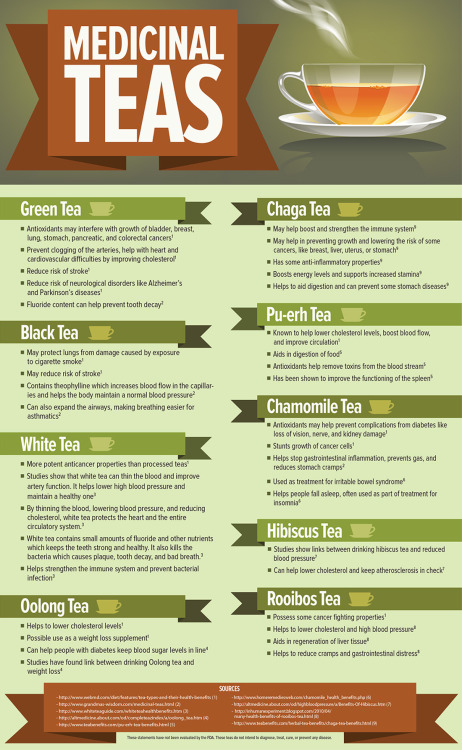


![How Gardening Benefits your Mind and Body [Visual]→ http://ecogreenlove.com/?p=15744While it may not How Gardening Benefits your Mind and Body [Visual]→ http://ecogreenlove.com/?p=15744While it may not](https://64.media.tumblr.com/5d8c0a40525668faad7a741167cc7c17/7c87b46acea7efbc-c6/s500x750/2bcda509521e2cd975755c578080488c2a1b78c0.png)








